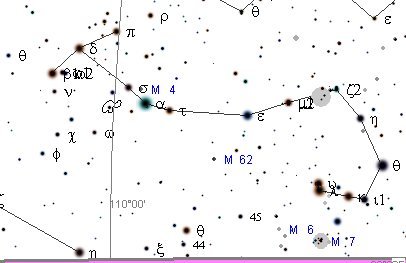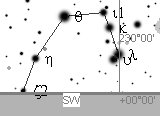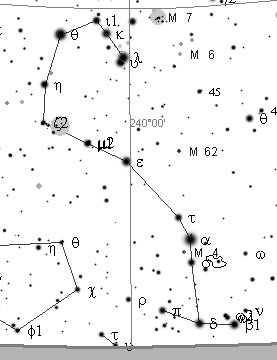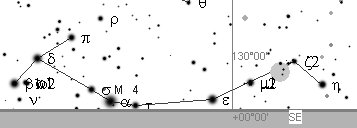2. By using the program Cartes du Ciel I have generated the following pictures:
The first star to rise in the Scorpion's head is π, about a day before Dchubba (δ) and about two days before Acrab (β) - with Lesath (ν) below Acrab. As input to the program I had my 'observatory' at latitude 26º S and the year was 1870. Scorpius is here rising in the east at 8.30 P.M. in 'May 1. Changing the date to 'April 1 (and keeping the rest of the inputs unchanged) Scorpius could not be seen, it was below the horizon in the east. But by increasing the time from 8.30 P.M. to 9.30 P.M. Scorpius had begun to emerge:
Scorpius was thus visible already before 'May 31, but it appeared later in the evening than at dusk. They had to wait until 'May 31 before Scorpius could be seen all night long: ... Antares is visible in the sky all night around May 31 of each year, when the star is at opposition to the Sun. At this time, Antares rises at dusk and sets at dawn. For approximately two to three weeks on either side of November 30, Antares is not visible in the night sky, because it is near conjunction with the Sun; this period of invisibility is longer in the Northern Hemisphere than in the Southern Hemisphere, since the star's declination is significantly south of the celestial equator ... In 'November 30 it would in principle have been possible to see a glimpse of the tail of Scorpius, when it followed after Sun and disappeared in the west, at 8.30. P.M.
One month earlier the whole constellation would have be seen at 8.30 P.M.
One month later than 'November 30 it could not be seen because it was below the horizon in the west. But by changing the time to 03.30 A.M. it would have been seen at the horizon in the east:
Thus a given constellation can probably be seen at least some time during the night, excepting those days when it is close to Sun, when it is rising heliacally and following Sun all day long, then to descend heliacally. At midnight a section covering 180º of the sky can be seen. 6 hours later the view will also be 180º, but with the western part of the midnight view now gone down and compensated for by a new part in the east, equally large. In a single night much more than 180º of the sky can be seen. The idea of a constellation being 'above' (i nika) in contrast to being 'below' (i raro) necessitates defining a time in the night for the observation: ... Ellis wrote of the natives of the Society and Tonga Islands, who called these stars Matarii, the Little Eyes: The two seasons of the year were divided by the Pleiades; the first, Matarii i nia, the Pleiades Above, commenced when, in the evening, those stars appeared on the horizon, and continued while, after sunset, they were above. The other season, Matarii i raro, the Pleiades Below, began when, at sunset, they ceased to be visible, and continued till, in the evening, they appeared again above the horizon. If we for instance wished to define seasons from Antares we could say Ana-mua i nika if Scorpius could be seen in the evening and Ana-mua i raro if at that time it was below the horizon. ... It [Antares] rises at sunset on the 1st of June, culminating on the 11th of July ... |




